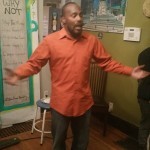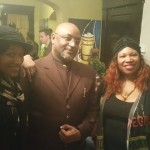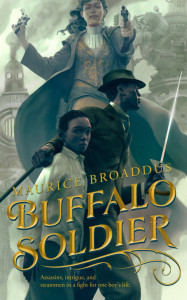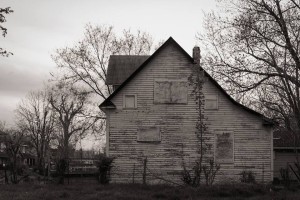Maurice Broaddus's Blog, page 14
April 27, 2017
The Power of Art: Community Development Through Writing
One of the things I’m passionate about is community development. In trying to figure out how to do this using writing, I became a part of an arts collective called The Learning Tree. We’re a group of organized neighbors that specializes in Asset Based Community Development (ABCD). We identify and invest in the individuals, organizations, and the community to see and celebrate the abundance in our neighborhood. Simply put, our neighbors are our business partners.
The community I work in, like other communities, is rich with gifted talented individuals who care about each other and their community but don’t have financial stability. The problem is that poor people aren’t being seen. There is a misrepresentation of poor people, in terms of who they are and what their capacity is to effect change within their communities. The dominant narrative about poor people or neighborhoods is that they are impoverished, broken, and filled with needs. Most stories of the poor focus on their economic and personal failures. Stories define a people. Stories reflect a people. Stories shape our perception, from the news to media to politics. The thing about stories, to paraphrase Neil Gaiman, is that it’s easy to let a bad one in you. Once labeled, it’s a constant battle not to live into that label.
WisCon 41 (May 26-29th): Where I’ll be
Saturday, May 27th, 1:00–2:15 pm
From Airships to Elder Gods
Tor.com authors and friends deconstruct steampunk, Lovecraftian monsters, and other richly deserving genre tropes. Ruthanna Emrys will read from her new novel Winter Tide. Maurice Broaddus will read from the recently released Buffalo Soldier. Anne M. Pillsworth will read from Redemption’s Heir, her Neo-Lovecraftian YA series. Samantha Lynn, a Long Hidden contributor, will read from her suburban Chicago dystopia-in-progress.
Maurice Broaddus, Ruthanna Emrys, S Lynn, Anne M. Pillsworth
Saturday, May 27th, 7:30-8:45 pm
Gaming (The Craft and Business of Writing)
People from a wide variety of career paths collaborate to make video games, including producers, programmers, directors, artists, and writers. However, the mythic ‘Ideas Guy’—the lone visionary genius at the center of a project—simply doesn’t exist. In this panel, video game developers will discuss their jobs and other jobs in the industry—and offer an inside look at how games are made.
M: Ann Lemay. Maurice Broaddus, Tanya D., Ceri Young
Saturday, May 27th, 9:00-10:15 pm
Power, Privilege, and Oppression (Gaming)
A recent Beyond Good & Evil 2 trailer featuring a picture of a rhinoceros with prominent dreadlocs. Black hairstyles offered as accessories for nonhuman characters. Nonhuman characters standing in for POC in otherwise white games. Let’s talk about the various ways that video games treat POC as other, and why the games industry needs to cut it out.
M: Tanya D., Kenzie Woodbridge. Maurice Broaddus, Na’amen Gobert Tilahun
April 26, 2017
Steampunk Symposium (April 28-30th) – Where I’ll be
Saturday, April 29th
7pm: The Steampunk Genre
What separates Steampunk from science fiction? How is it different from Gaslamp Fantasy or Dieselpunk? What are some of the classic must-read examples of Steampunk, and why do we love them so much? Panelists discuss all of this and more in this panel on our favorite genre. Panelists discuss what details make a story or novel fit into the steampunk genre, including a recommended reading list! – Moderator Sarah Hans, Panelists: KW Jeter, Cherie Priest, Leanna Renee Hieber, Maurice Broaddus
9pm: Read Your Favorite Page
Our Literary Guests join us to read a tiny tidbit of their favorite work, come see what our lit track loves the most!
Sunday, April 30th
10:30: Envisioning a Better Steam Society roundtable led by Diana Pho
Description: A discussion panel where panel participants discuss their thoughts about finding aesthetic inspiration in a historical era rife with sexism, racism and classist thinking. Can the steampunk subculture come to terms with its problematic past, or are we just repeating history, except with ray guns? Together with the audience, we hope to engage in an open dialogue about whether steampunk confronts or condones the historical ideas behind its inspiration, how nineteenth century thinking is re-interpreted in the present day, and what makes steampunk actually “punk.”
April 25, 2017
FREE READ: At the Village Vanguard (Ruminations on Blacktopia)
Up on the Mothership Zeta site is one of my favorite stories, At the Village Vanguard (Ruminations on Blacktopia). As they say, to use a phrase in the text below, this story is “straight up blackity-black,” indicative of Maurice Broaddus’s singular voice. If you’re not already a fan of Afrofuturism, this will hook you.
At the Village Vanguard (Ruminations on Blacktopia)
by Maurice Broaddus
In this, the 25th anniversary of the founding of the lunar colony, First World (colloquially called Blacktopia by its residents), The Indianapolis Recorder, the nation’s oldest-surviving African-American newspaper, continues its series re-visiting key events. Their reporter interviewed (and re-interviewed) many of the principals in order to piece together a picture of the terrorist threat that nearly ended it and the heroic actions of Science Police Officer, Astra Black.
Jiminy Crootz (aka J-Croo, Science Police, Senior Investigator. Retired.)
When the alarms sounded for the converter station, I had no doubt she would beat me there. The gate surrounding the solar panel farm had been slit open, like someone wanted to perform a Caesarean but only had a rusted pair of clippers at their disposal. The backdoor of the converter station had been battered in. The air, heavy and re-breathed, like the filters weren’t working at full efficiency. Panels ripped open, wires everywhere. Nanobots probably skittered across the room like roaches in my aunty’s old kitchen. The farm was strictly a backup source of power for the lunar colony, so it wasn’t as heavily guarded as say the nuclear fission power station or the magnetic generators. But there was still a man down and Astra Black stood over his body.
HAPPY BOOK LAUNCH DAY (plus The Big Idea)!
Happy book launch day to me! Buffalo Soldier is now out and about. Over on John Scalzi‘s blog, I write about the Big Idea. And the role my mom played in the story, because apparently I don’t talk about her enough. Or call enough.
***
The Big Idea: Maurice Broaddus
April has been light on Big Idea posts because I’m on tour (don’t worry, May’s gonna be packed), but let’s make sure we don’t get through this last week of the month without a fine piece of work for you to consider. Today: Maurice Broaddus brings you all the details on his new novella Buffal0 Soldier, including who the work is a love letter for.
MAURICE BROADDUS:
My novella, Buffalo Soldier–in fact the entire saga of its hero, Desmond Coke–is essentially one long love letter to my mother.
April 24, 2017
Apex Magazine’s New Reprints Editor

Apex Publications
Contact: Lesley Conner, Managing Editor
lesley@apex-magazine.com
Apex Publications is proud to announce that author/editor Maurice Broaddus has taken on the role of reprints editor for Apex Magazine. Apex Magazine publishes one reprint in each issue. Maurice will be responsible for finding those reprints beginning with issue 98, July 2017.
Maurice Broaddus and Apex Publications have a long history together going back 10 years. He has been published in several of our anthologies, including most recently in Upside Down: Inverted Tropes in Storytelling edited by Monica Vallentinelli and Jaym Gates. He has also had several books published through Apex, including Orgy of Souls (co-written by Wrath James White), I Can Transform You, and the anthologies Dark Faith and Dark Faith: Invocations which he co-edited with Jerry Gordon. Most recently, Maurice Broaddus guest edited an issue of Apex Magazine—issue 95 (http://www.apex-magazine.com/issue-95...), which included original fiction by Walter Mosley, Chesya Burke, Sheree Renee Thomas, and Kendra Fortmeyer, poetry by Linda D. Addison and LH Moore, and nonfiction by Tanya C. DePass.
We are extremely excited to see what reprints he will bring to the magazine each and every month, and to have Maurice be part of the Apex Magazine team.
APEX PUBLICATIONS (www.apexbookcompany.com) is a small press dedicated to publishing exemplary works of science fiction, fantasy, and horror. Owned and operated by Jason B. Sizemore, Apex publishes the thrice Hugo Award-nominated Apex Magazine. The Apex catalog contains books by genre luminaries such as Damien Angelica Walters, Catherynne M. Valente, and Brian Keene.
April 20, 2017
Uh Oh! Here Come the Artists
(Ruminations on Art, Race, and Gentrification)
“The larger the amount of money that flows to the poor apart from relationship, the more likely the givers are to be supporting systems that caused the injustice in the first place.” David E Fitch, Faithful Presence
The relationship between art and gentrification has become so fraught that when some communities see artists moving in, they start a mental countdown clock to their eventual ejection. The scenario plays out in too many variations, from New York to Detroit, to ignore it. Indianapolis has seen small iterations of such transformation in Fountain Square, sending a ripple of fear through different communities not wanting to see the same story repeat.
People rarely agree on the definition of gentrification, often falling back to something analogous to Supreme Court Justice Potter Stewart’s characterization of pornography: “I know it when I see it.” However, to paraphrase Ruth Glass’ original definition of gentrification, it’s when the original occupiers of a neighborhood become displaced and the whole social character of a neighborhood soon changes. As WildStyle Paschall puts it, “GENTRIFICATION is when development causes property taxes to go up so high that homeowners can’t afford it and leave. But its NEVER that simple.” While he does on to describe the collusion between predatory property taxes and out of state speculators, there are other aspects to look at.
The story of gentrification begins when someone—be they artist, developer, business person, city official, or community stakeholder—an area of town that has been abandoned by the middle class and forgotten by the city. They declare that area of town dead or in need of renewed attention. This declaration of death is critical because with nothing of value seen/apparently going on in that area, they can move in and take possession of the land. They can displace natives and change the neighborhood for the better for use by the new/future residents. It is urban colonization under the polite guise of redevelopment, renewal, or revitalization. Words mean things: redevelopment, renewal, and revitalization imply that a place was undeveloped, broken, and dead, all with the tidy bonus of labeling those still living there as the problem rather than the people, businesses, and political forces who fled the area in the first place. By those same people, businesses, and political forces now “discovering” that place, gentrification becomes neocolonialism.
This goes a long way to explaining why some people panic when they see the gentrifying pioneers—artists, college students, and young professionals on the rise—moving in. They know that as long time residents, they are reduced to neighborhood flavor. They can only watch as the character of their neighborhood metamorphosing into something unrecognizable, like a series of cafes and breweries. Residents get caught either by being long term renters with no set financial footing in the neighborhood (read: easily displaced) or get priced out due to higher property taxes (rather than have clauses in place to protect them).
The problem with the “artists” in this scenario is that too often they are privileged, well-intended, naive people with savior complexes. Though they bring excitement and attention, with a mission to beautify, the key thing to remember is that they come in from the outside. They define what’s beauty and art by imposition. They paint new stories on the canvass of the old neighborhood. And they forget the people, at best; or see them as objects to an end, at worst. By being imported in, the message sent to that community is that “we don’t know you, we don’t value you, and we have a better way of doing things.”
Such artists don’t stop to ask what a community’s capacity to beautify itself (read: they don’t talk to residents). Ideas, visions, and priorities are heard differently when they come in from the outside rather than from within the community. Whether such artists realize it or not, they cut the neighborhood from its history, heritage, and legacy (read: disconnect the residents). Whether they operate out of such naivete or simply without guiding principles, they risk becoming opportunists whose sole mission is to chase grant money and recognition.
In turn, the arts collective becomes a pawn for those with the power to gentrify. Developers invest in communities while their political partners in local government provide incentives. They target black, brown, and poor white communities—all of whom have being disenfranchised, marginalized, and impoverished in common—not bothering to talk to the community residents. For the sake of short term profits, neighborhoods along with their history and culture become the collateral damage.
As a city, we quietly balk when we have too much investment by foreign nations. We recognize the dangers of someone coming in from the outside and staking financial claims where we live. We know that whoever controls the purse strings, whoever can call in debt markers, has the real power. Yet we fail to see the irony of that being played out in neighborhoods facing down such unchecked development.
Keep in mind the history of how many of those communities were formed. Some were displaced by previous development (see the construction of IUPUI). Some grew up in the shadow of segregation (see the history of America). Some were settled as African American migrants sought increased opportunity and/or escape from racial violence (again, see the history of America). The repeated forces of segregation, red-lining, and neglect by local government come together as the familiar backdrop to the gentrification conversation.
History has repeatedly shown that race, class, and power (economic and political) if combined poorly only leave destruction. Similarly, few like to point out the class and race divisions within art. Art is a tether to elitism, with arts collectives seen as white producers for white consumers. As such, the conversation shifts from “what is art?” to “who’s art is it?” But art can also work to unite. It can pursue social justice across race and class lines, questioning social constructs from privilege to supremacy. If an arts collective is not interested in being part of the community, if it’s not interested in working with the community, then it’s just there to change it. Change it into something they are comfortable with, which, unsurprisingly, looks like a reflection of themselves.
Development shouldn’t equal destruction. Investment in community done well releases the power of the residents, reminds them of the power they already have. In order to have a good reputation in the community, artists, and more importantly those who fund them, need to have a shift from what Reverend Mike Mathers of Broadway United Methodist Church calls a “master” mindset to a “servant” mindset.
A master mindset moves with the arrogance that “we have the answer.” In practice, it looks like them showing up uninvited to bring art to beautify a neighborhood as if no one in the neighborhood has the capacity to do so themselves. A master mindset “rebrands” a neighborhood to attract a new or wealthy demographic. This is why even the simple act of branding/naming is important. Every person wants the power to identify themselves because there is inherent power to the namer. Masters name. The namer has authority over those named so naming becomes political and re-naming becomes erasure.
Under a servant model, a person asks “how can we support what you’re already doing?” A servant follows the community. Servants serve. Servants go do the research and asks questions of their neighbors. They go and talk to everyone within the first few blocks around them and begin to build trust equity. They tap into the creativity and passions of the people within their community rather than just bring in more people like them.
The problem isn’t engagement, it’s the process. Just as “game recognizes game,” in the chase of grants “money recognizes money.” Arts collectives suffer mission drift and identity loss as they write grants about places they’ve never been to work on people they don’t know. As they mount projects more about glitz and glamour to get their name in the paper in order to get more funding. If there are no guiding principles beyond chasing money, the door to gentrification opens.
Responsible investment in neighborhoods brings positive change that can benefit everyone: repaired sidewalks, fixed streetlights, additional green space, cleaned waterways, and the elimination of food deserts. The current residents want this. Community development done in a healthy way requires a commitment to the people of their community. It recognizes the inherent dignity and worth of its neighbors. A new model of community development and resident engagement through art collectives begins with learning to collaborate, demonstrating a partnership between organizations, activists, residents, and artists to serve and better our communities. It can help rebuild the social fabric. Listen to what your neighbors want. Know what your neighbors are doing. Let your neighbors know “we see you and we value you.” We risk losing the role of the artist as prophet, to speak truth to power. As part of art’s role is to reveal our humanity, what makes us most human, it must demonstrate a radical imagining of art to capture story, reflect story, to protest, and to protect.
“Charity to urban black communities is NOT the equivalent of transformative Justice. You can give charitably to a community for years but not contribute to its fundamental transformation towards human flourishing. In many ways, if your only posture to that community is charity you may actually exacerbate and embolden poverty and degradation in a community.” -Anthony Smith
April 18, 2017
A story, an essay, and a sneak peek
I’ll have a story, “The Rebel” (co-written with Sarah Hans), in MECHANICAL ANIMALS, ed. Selena Chambers and Jason Heller. I look forward to seeing that full table of contents.
Speaking of a table of contents, check out this one for People of Color Take Over Fantastic Stories of the Imagination, ed. Nisi Shawl (who, when she read my essay, dubbed me the nerd of nerds):
Fiction
What Futures by Su-Yee Lin
Shadow Animals by Stephen Graham Jones
Darkout by E. Lily Yu
The Executioner by Jennifer Marie Brissett
I Understand by Jermaine McGill
Walking Round Money by Paul Miles
Serving Fish by Christopher Caldwell
Fortitude by Eliza Victoria
The Sacrifice of the Hanged Monkey by Minsoo Kang
Maggie Doll by Alex Jennings
Glass Bottle Trick by Nalo Hopkinson
The Great Leap of Shin by Henry Lien
The Palapye White Birch by Tlotlo Tsamaase
The Ace of Knives by Tonya Liburd
Legacy by Irette Y. Patterson
Recognizing Gabe: un cuento de hadas by Alberto Yanez
Non Fiction
Must Watch TV: Into the Badlands by S. Qiouyi Lu
Rebirth, Truth-with-a-Tea, and FIYAH by Erin Roberts
Read Me! 7 by Terence Taylor
Hopefulbright to the Rescue! by Darcie Little Badger
Star Trek’s Lt. Cmdr. Worf and His Journey of Ontological Klingon-ness by Maurice Broaddus
Lastly, can’t wait another week for Buffalo Soldier to drop? Here’s a sneak peak posted over on Tor.
April 7, 2017
Help Me get to Romania
If you’d like to give toward it, the Harrision Center for the Arts is acting as my fiscal agent. You can donate online through their website with a note or call in with a credit card. I thank you in advance and look forward to reporting back.
April 5, 2017
The Learning Tree Presents Sawubona 46208 – The Living Room Concert
Tonight was the first of a series of living room concerts The Learning Tree plans on putting on over the next few months. We at The Learning Tree want to showcase and celebrate the gifts and talents present in our neighborhood. Culinary artists, writers, poets, musicians, activists, organizers, videographers, and visual artists all within a few blocks. The people here, doing the work to effect change. The goal of the concerts is to network and connect them with people with resources who also want to effect change. To figure out ways to support the work that’s already being done, but that’s not always seen.
Tonight’s featured artists were Leslie Red, Januarie York, and Damon Dulin (with special appearances by Ro Townsend and Earl E. Townsend, whose Open Bite Night Revolution is coming up in a few weeks).
[And you’ll have to forgive my crappy pictures. I’ll soon be posting pics by Wildstyle Paschall and Diop Adisa on The Learning Tree site when I get them]
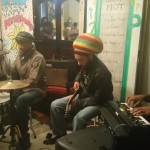
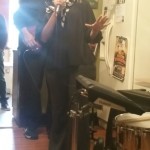



[image error]
